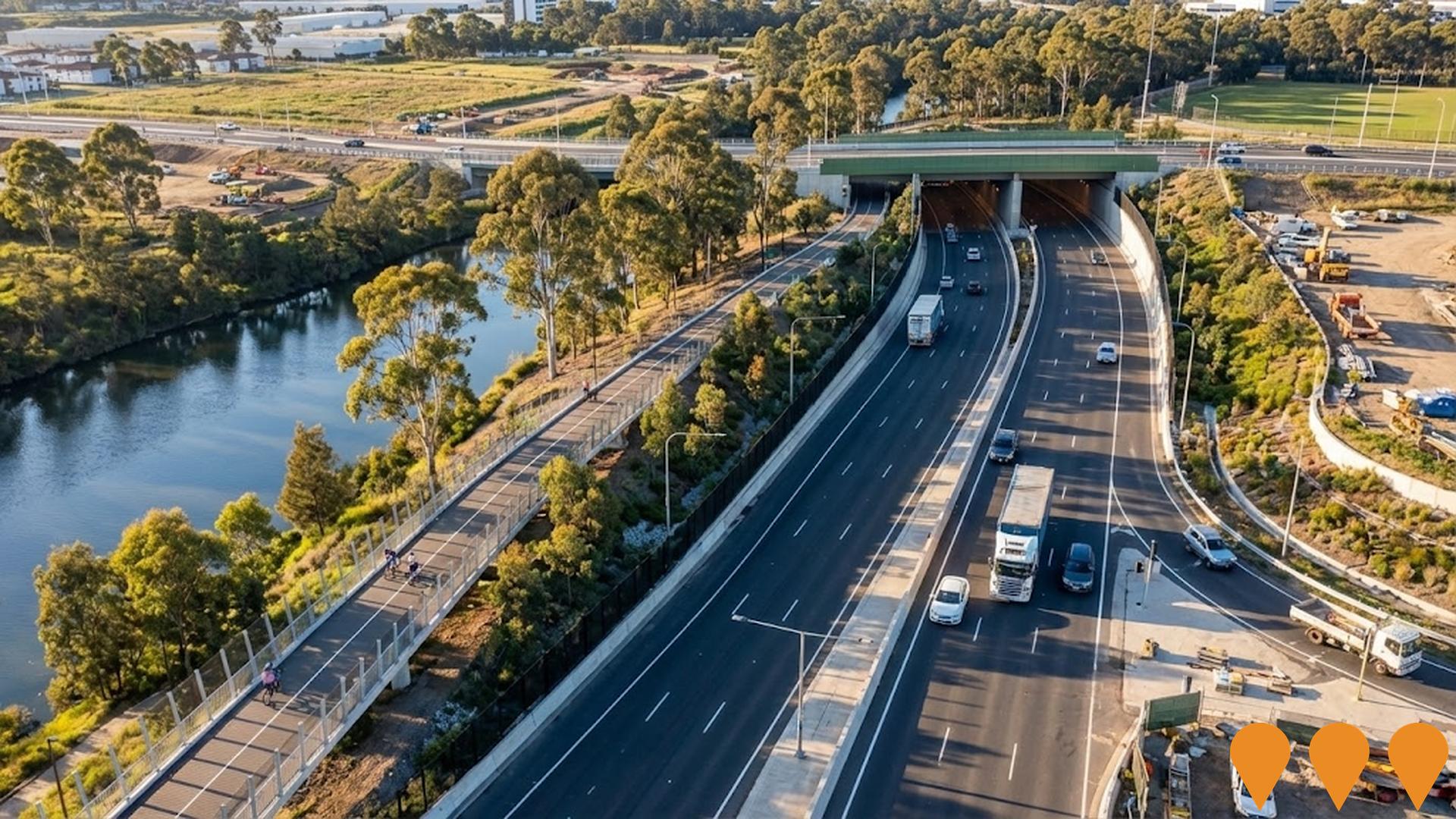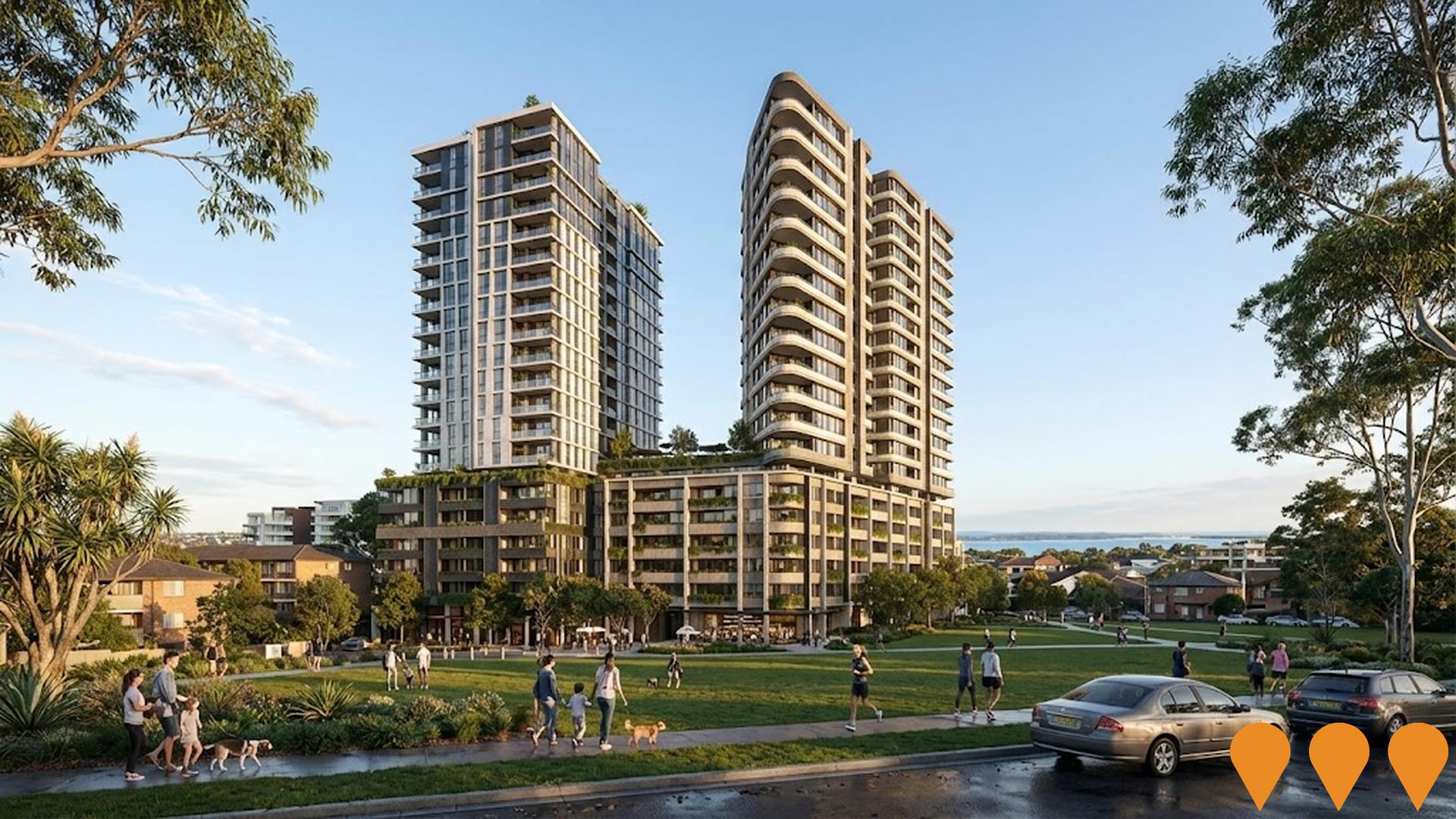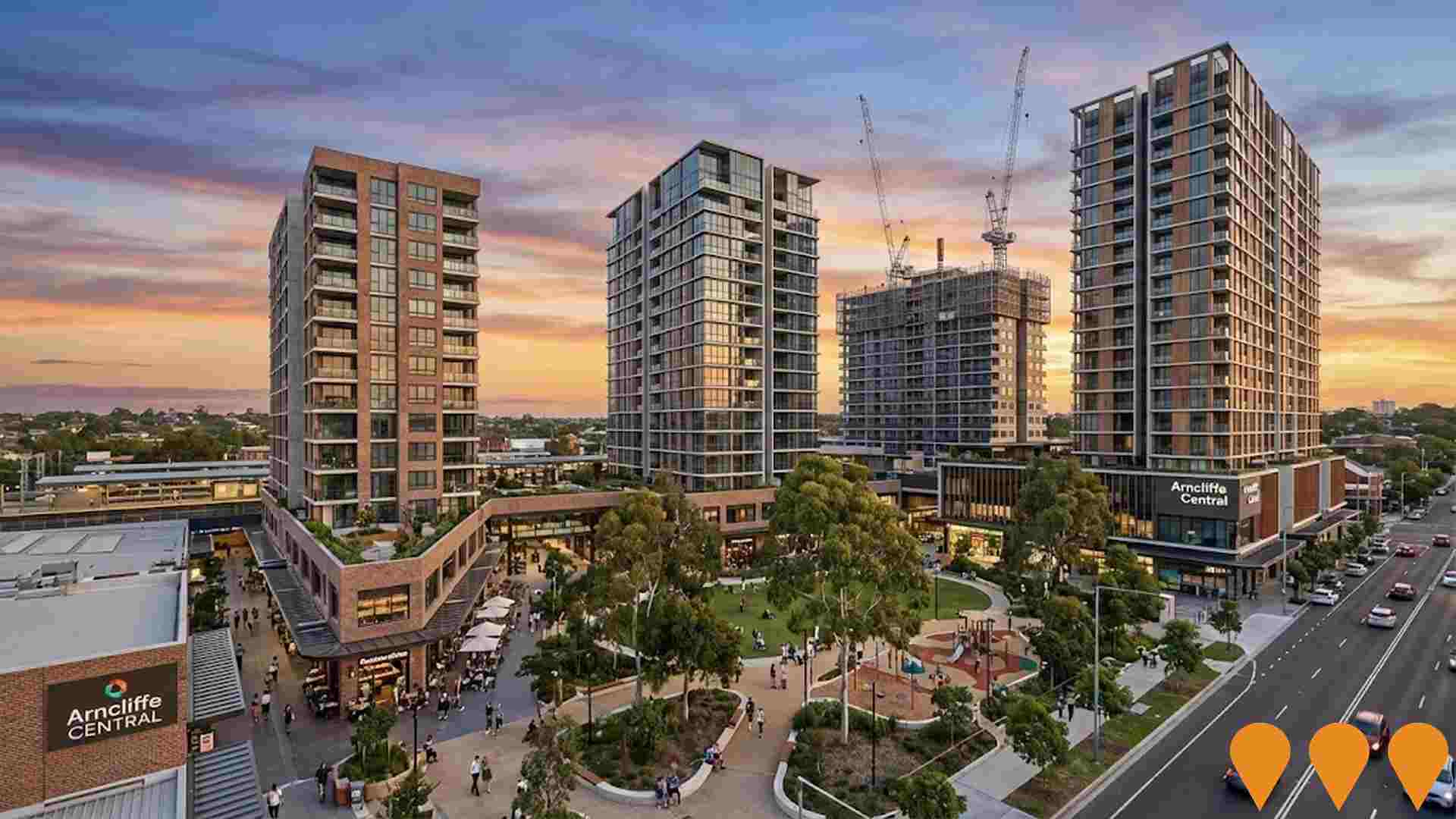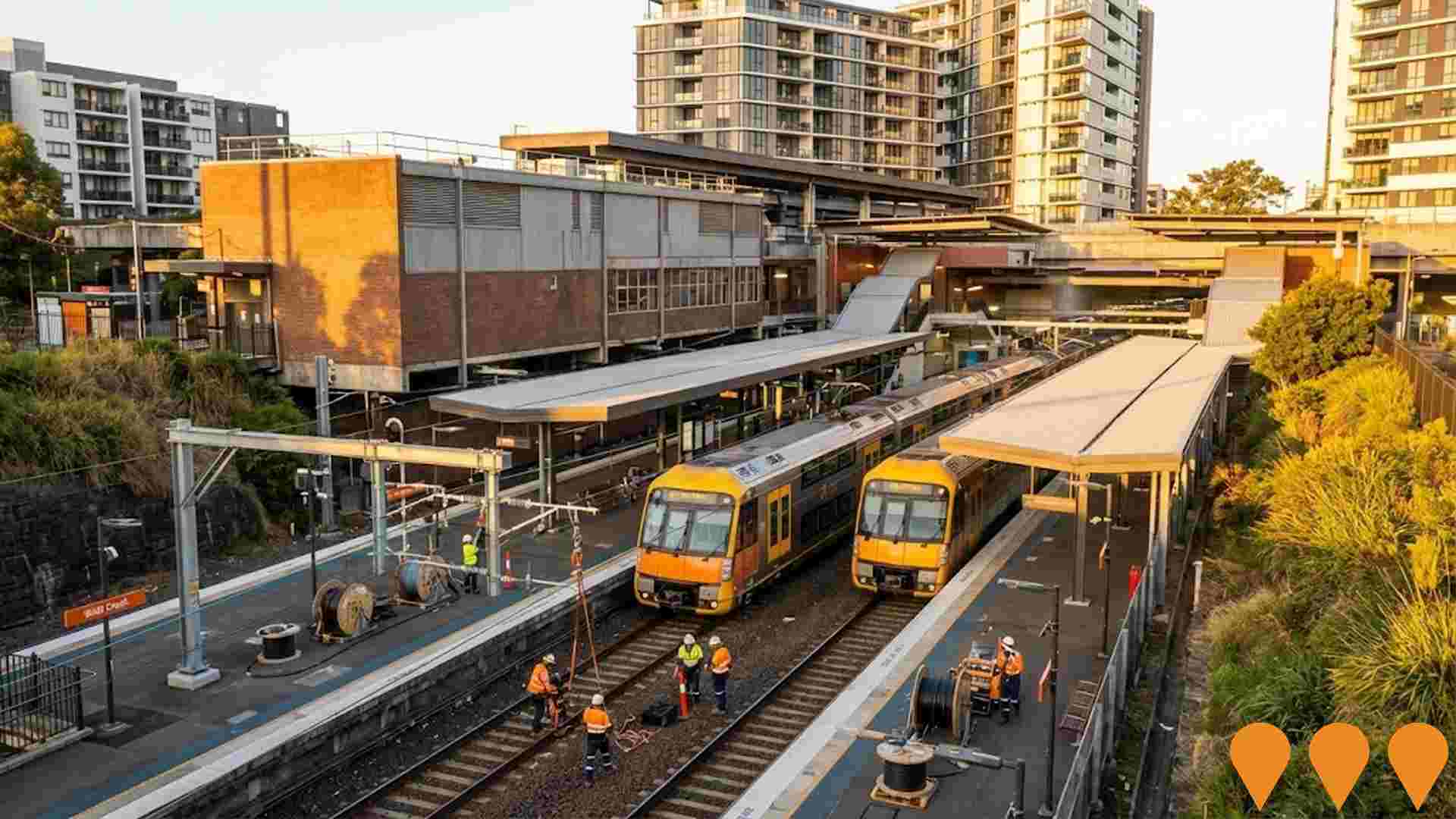Chart Color Schemes
est. as @ -- *
ABS ERP | -- people | --
2021 Census | -- people
Sales Activity
Curious about local property values? Filter the chart to assess the volume and appreciation (including resales) trends and regional comparisons, or scroll to the map below view this information at an individual property level.
Find a Recent Sale
Sales Detail
Population
Arncliffe - Bardwell Valley lies within the top quartile of areas nationally for population growth performance according to AreaSearch analysis of recent, and medium to long-term trends
Arncliffe-Bardwell Valley's population is 18,154 as of Aug 2025. This shows an increase of 1,575 people since the 2021 Census, which reported a population of 16,579. The change was inferred from ABS estimates and new addresses validated post-Census. The area's population density is 4,212 persons per square kilometer, placing it in the top 10% nationally. Arncliffe-Bardwell Valley's growth rate since 2021 (9.5%) exceeded both its SA4 region (5.3%) and state averages, driven primarily by overseas migration contributing approximately 78.3% of population gains. AreaSearch uses ABS/Geoscience Australia projections for each SA2 area, released in 2024 with a 2022 base year.
For areas not covered, NSW State Government's SA2 level projections are used, released in 2022 with a 2021 base year. Growth rates by age group are applied to all areas from 2032 to 2041. Based on latest numbers, the area is projected to grow by 4,447 persons to 2041, recording a gain of 22.9% over 17 years.
Frequently Asked Questions - Population
Development
AreaSearch assessment of residential development activity positions Arncliffe - Bardwell Valley among the top 25% of areas assessed nationwide
Arncliffe-Bardwell Valley has seen approximately 201 new homes approved each year over the past five financial years, totalling 1,007 homes. As of FY-26, 66 approvals have been recorded. On average, 1.2 new residents per year have been associated with each dwelling constructed between FY-21 and FY-25, indicating a balanced supply and demand market that supports stable conditions.
The average construction cost value of new homes is $501,000. Compared to Greater Sydney, Arncliffe-Bardwell Valley has seen 113.0% more building activity per person, offering greater choice for buyers and reflecting robust developer interest in the area. Of the new building activity, 6.0% consists of standalone homes, while 94.0% comprises townhouses or apartments, marking a shift from the current housing pattern of 44.0% houses. This trend suggests diminishing developable land availability and responds to evolving lifestyle preferences and housing affordability needs, with around 229 people per dwelling approval indicating a developing market. By 2041, Arncliffe-Bardwell Valley is projected to add approximately 4,167 residents. Given current development patterns, new housing supply should meet demand, potentially facilitating population growth beyond current projections.
Future projections show Arncliffe - Bardwell Valley adding 4,167 residents by 2041. Based on current development patterns, new housing supply should readily meet demand, offering good conditions for buyers and potentially facilitating population growth beyond current projections.
Frequently Asked Questions - Development
Infrastructure
Arncliffe - Bardwell Valley has very high levels of nearby infrastructure activity, ranking in the top 20% nationally
Infrastructure changes significantly influence an area's performance. AreaSearch has identified 52 projects likely impacting the area. Key projects include Arncliffe Estate Redevelopment, Arncliffe Central, Arncliffe Park Upgrade, and Bayside West Precincts 2036 Plan. The following list details those most relevant.
Professional plan users can use the search below to filter and access additional projects.
INFRASTRUCTURE SEARCH
 Denotes AI-based impression for illustrative purposes only, not to be taken as definitive under any circumstances. Please follow links and conduct other investigations from the project's source for actual imagery. Developers and project owners wishing us to use original imagery please Contact Us and we will do so.
Denotes AI-based impression for illustrative purposes only, not to be taken as definitive under any circumstances. Please follow links and conduct other investigations from the project's source for actual imagery. Developers and project owners wishing us to use original imagery please Contact Us and we will do so.
Frequently Asked Questions - Infrastructure
Bayside West Precincts 2036 Plan
The Bayside West Precincts 2036 Plan is the approved strategic planning framework for the renewal of the Arncliffe, Banksia and Cooks Cove areas in Sydney's south. It supports the delivery of approximately 5,000 new homes (with potential for more under review), new parks and open space, upgraded community facilities, local employment opportunities, active transport links and revitalisation of town centres and the Princes Highway corridor over the period to 2036 and beyond.

Northern Georges River Submain Upgrade
Critical wastewater infrastructure upgrade to the Northern Georges River Submain (NGRS), a major concrete sewer network in Sydney's south west. The work involves relining and renewing sections of the large-diameter pipeline (up to 2.5m in diameter) due to corrosion from sewage gas (H2S attack). This trenchless technology renewal work is part of a broader, long-term program to increase network capacity in the NGRS and Malabar System, improving system resilience and environmental performance by reducing wet weather discharge and odour emissions.

M6 Stage 1 (St Peters to Kogarah)
Construction of M6 Stage 1 motorway connecting St Peters to Kogarah, featuring twin four-kilometre tunnels, new interchanges, and a new five-kilometre shared pedestrian and cyclist pathway. The project aims to reduce congestion on local roads, bypass up to 23 sets of traffic lights on the Princes Highway, and link Sydney's south to the wider motorway network. The expected completion has been delayed from late 2025 to late 2028 due to two subsidence incidents in March 2024. As of July 2025, surface works and shared path construction are being prioritised, with nearly 90 per cent of tunnelling complete.

Arncliffe Estate Redevelopment
Arncliffe Central is a transformative mixed-tenure redevelopment replacing 142 ageing dwellings with 806 new residential units comprising four towers ranging from 17 to 21 storeys. The development includes 196 social housing units, affordable housing, and private market apartments integrated with a 4,000 sqm public park, retail precinct featuring supermarket and cafes, childcare centre, community centre and library. Construction commenced in 2023 with the project representing one of the largest mixed-tenure housing developments in NSW, delivered in partnership between NSW Land and Housing Corporation, Billbergia Group, Evolve Housing, and St George Community Housing.

Arncliffe Central
Major mixed-use urban renewal precinct adjacent to Arncliffe Station. Delivers 806 apartments (180 social housing by Evolve Housing, 231 affordable housing by SGCH, 395 private apartments) across four towers up to 21 storeys. Includes 4,000 sqm central park, 3,353 sqm retail precinct with full-line supermarket, specialty shops, cafes, 100-place childcare centre, community facilities and over 810 car spaces. Jointly developed by Homes NSW, Billbergia Group, Evolve Housing and St George Community Housing.

Wolli Creek and T8 Airport Line Power Supply Upgrade
Major rail infrastructure upgrade delivering power supply enhancements along the T8 Airport Line tunnel from Central to Wolli Creek Junction. Part of the Rail Service Improvement Program (formerly More Trains More Services), the project includes construction of a new substation at Wolli Creek Junction (5A Lusty Street), installation and modification of 6km of overhead wiring and new power supply cables throughout the tunnel from Chalmers Street substation through to Green Square, Mascot and Wolli Creek stations, installation of new power supply cable between Chalmers Street Substation and Rail Operations Centre at Green Square, signalling system upgrades, platform canopy extensions at Wolli Creek Station, and decommissioning of redundant substations at Undercliffe and Wolli Creek signalling hut. The upgrade will support increased train services on the T8 Airport Line including an 80% increase at Airport stations, accommodate new train fleets, and future-proof the Sydney Trains network for additional services and capacity while enhancing grid reliability for growing residential, commercial and logistics developments in the area.

Arncliffe Park Upgrade
Major upgrade to Arncliffe Park including new playground equipment, improved sporting facilities, landscaping and pathways. Part of $4.5M funding from NSW Government Precinct Support Scheme supporting Bayside West Precincts 2036 Plan. Enhanced community recreation and open space. The upgrade is associated with the M6 Stage 1 project.

67-73 West Botany Street Heritage Development
10-level development by Buildview Corp with 60 apartments incorporating Victorian-era heritage cottage facades at ground level. Mixed residential and commercial development with retail spaces, heritage interpretation centre, and landscaped courtyards. Balances heritage preservation with contemporary housing needs.

Employment
Employment performance in Arncliffe - Bardwell Valley exceeds national averages across key labour market indicators
Arncliffe - Bardwell Valley has a highly educated workforce with professional services showing strong representation. The unemployment rate was 3.1% as of June 2025.
Employment growth over the past year was estimated at 2.2%. There were 10,935 residents in work in June 2025, with an unemployment rate of 1.1% below Greater Sydney's rate of 4.2%. Workforce participation was somewhat below standard at 57.2%, compared to Greater Sydney's 60.0%. Key industries of employment among residents were health care & social assistance, professional & technical, and retail trade.
The area had particular employment specialization in transport, postal & warehousing, with an employment share of 1.7 times the regional level. Health care & social assistance was under-represented, with only 11.3% of Arncliffe - Bardwell Valley's workforce compared to 14.1% in Greater Sydney. Employment opportunities locally appeared limited based on Census working population vs resident population count. Over the 12 months to June 2025, employment increased by 2.2% while labour force increased by 2.6%, causing the unemployment rate to rise by 0.4 percentage points. By comparison, Greater Sydney recorded employment growth of 2.6%, labour force growth of 2.9%, with unemployment rising 0.3 percentage points. Jobs and Skills Australia's national employment forecasts from May 2025 projected national employment expansion at 6.6% over five years and 13.7% over ten years, with varying growth rates between industry sectors. Applying these projections to Arncliffe - Bardwell Valley's employment mix suggested local growth of approximately 6.7% over five years and 13.5% over ten years.
Frequently Asked Questions - Employment
Income
Income analysis reveals strong economic positioning, with the area outperforming 60% of locations assessed nationally by AreaSearch
Arncliffe-Bardwell Valley had a median taxpayer income of $52,956 and an average income of $65,525 in the financial year 2022, according to postcode level ATO data aggregated by AreaSearch. This is comparable to national averages but lower than Greater Sydney's median income of $56,994 and average income of $80,856. By September 2025, estimated incomes would be approximately $59,634 (median) and $73,788 (average), based on a 12.61% increase since financial year 2022. In the 2021 Census, Arncliffe-Bardwell Valley's household, family, and personal incomes were at the 64th percentile nationally. The majority of residents, 35.7% (6,480 individuals), earned between $1,500 and $2,999 annually, similar to regional patterns where 30.9% fell within this range. Housing costs consumed 18.5% of income in the area. Despite high housing costs, disposable income was at the 66th percentile nationally, with the area's SEIFA income ranking placing it in the 7th decile.
Frequently Asked Questions - Income
Housing
Arncliffe - Bardwell Valley features a more urban dwelling mix with significant apartment living, with ownership patterns similar to the broader region
Arncliffe-Bardwell Valley's dwellings, as per the latest Census, were 43.8% houses and 56.2% other types (semi-detached, apartments, 'other'). Sydney metro had 39.8% houses and 60.3% others. Home ownership in Arncliffe-Bardwell Valley was 27.1%, with mortgaged dwellings at 33.7% and rented ones at 39.2%. The median monthly mortgage repayment was $2,400, higher than Sydney's average of $2,383. Median weekly rent in Arncliffe-Bardwell Valley was $500, compared to Sydney's $480. Nationally, mortgage repayments averaged $1,863 and rents were $375.
Frequently Asked Questions - Housing
Household Composition
Arncliffe - Bardwell Valley features high concentrations of group households, with a higher-than-average median household size
Family households constitute 71.9% of all households, including 32.7% couples with children, 26.6% couples without children, and 10.5% single parent families. Non-family households account for the remaining 28.1%, with lone person households at 21.5% and group households comprising 6.7%. The median household size is 2.7 people, larger than the Greater Sydney average of 2.6.
Frequently Asked Questions - Households
Local Schools & Education
The educational profile of Arncliffe - Bardwell Valley exceeds national averages, with above-average qualification levels and academic performance metrics
The area's educational profile is notable regionally with university qualification rates at 39.7% for residents aged 15+, exceeding the Australian average of 30.4% and NSW average of 32.2%. Bachelor degrees are most prevalent at 26.9%, followed by postgraduate qualifications (10.8%) and graduate diplomas (2.0%). Vocational credentials are also prominent, with 25.5% of residents aged 15+ holding such qualifications – advanced diplomas (11.3%) and certificates (14.2%).
Educational participation is high at 33.1%, including 8.5% in primary education, 7.5% in tertiary education, and 6.7% pursuing secondary education. Six schools operate within Arncliffe - Bardwell Valley, educating approximately 1,998 students. The area has above-average socio-educational conditions with an ICSEA score of 1058. The educational mix includes four primary schools and two K-12 schools.
Frequently Asked Questions - Education
Schools Detail
Nearby Services & Amenities
Transport
Transport servicing is good compared to other areas nationally based on assessment of service frequency, route connectivity and accessibility
Arncliffe-Bardwell Valley has 49 active public transport stops operating within its boundaries. These stops offer a mix of train and bus services. The area is served by 11 individual routes that collectively facilitate 4,332 weekly passenger trips.
Transport accessibility in the region is rated as excellent, with residents typically residing just 176 meters from their nearest transport stop. On average, service frequency across all routes amounts to 618 trips per day, translating to approximately 88 weekly trips per individual stop.
Frequently Asked Questions - Transport
Transport Stops Detail
Health
Arncliffe - Bardwell Valley's residents boast exceedingly positive health performance metrics with younger cohorts in particular seeing very low prevalence of common health conditions
Health outcomes data shows notable results across Arncliffe - Bardwell Valley, with younger cohorts experiencing very low prevalence of common health conditions.
The rate of private health cover is approximately 52%, leading that of the average SA2 area (~9,512 people). Mental health issues and arthritis are the most common medical conditions in the area, impacting 5.4% and 5.3% of residents respectively. A total of 78.3% of residents declare themselves completely clear of medical ailments, compared to 77.5% across Greater Sydney. The area has 12.4% of residents aged 65 and over (2,256 people), lower than the 16.4% in Greater Sydney. Health outcomes among seniors require particular attention despite being strong overall.
Frequently Asked Questions - Health
Cultural Diversity
Arncliffe - Bardwell Valley is among the most culturally diverse areas in the country based on AreaSearch assessment of a range of language and cultural background related metrics
Arncliffe-Bardwell Valley is among the most culturally diverse areas in Australia, with 49.3% of its population born overseas and 58.4% speaking a language other than English at home. Christianity is the predominant religion, making up 40.0% of people in Arncliffe-Bardwell Valley. However, Islam is significantly overrepresented at 21.6%, compared to Greater Sydney's average of 10.3%.
The top three ancestry groups are Other (20.4%), Australian (12.4%), and English (12.0%). Notably, Lebanese ethnicity is overrepresented at 11.6% compared to the regional average of 5.2%, Macedonian at 4.5% versus 3.8%, and Spanish at 0.9%.
Frequently Asked Questions - Diversity
Age
Arncliffe - Bardwell Valley hosts a young demographic, positioning it in the bottom quartile nationwide
Arncliffe-Bardwell Valley's median age is 34 years, which is lower than Greater Sydney's average of 37 years and Australia's average of 38 years. Compared to Greater Sydney, Arncliffe-Bardwell Valley has a higher proportion of residents aged 25-34 (22.5%) but fewer residents aged 5-14 (9.4%). This concentration of 25-34 year-olds is significantly higher than the national average of 14.5%. Between the 2021 Census and now, the proportion of residents aged 35-44 has increased from 15.6% to 17.4%, while the proportion of those aged 45-54 has decreased from 11.2% to 10.3%. By 2041, population forecasts suggest significant demographic changes for Arncliffe-Bardwell Valley. The 35-44 age group is projected to grow by 84%, adding 2,671 residents to reach a total of 5,836. In contrast, population declines are projected for the 25-34 and 15-24 age groups.
